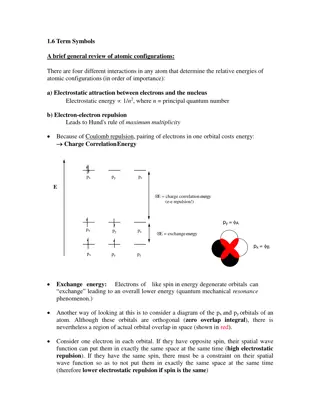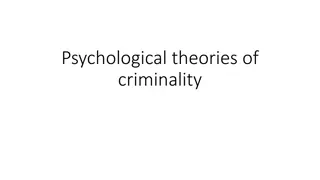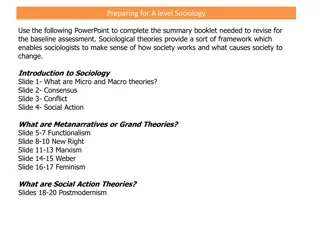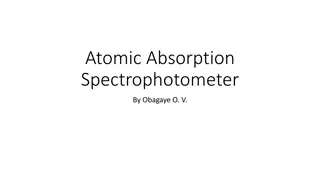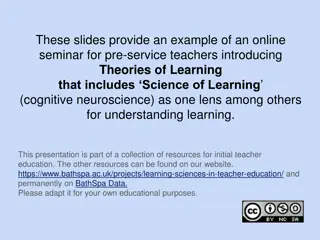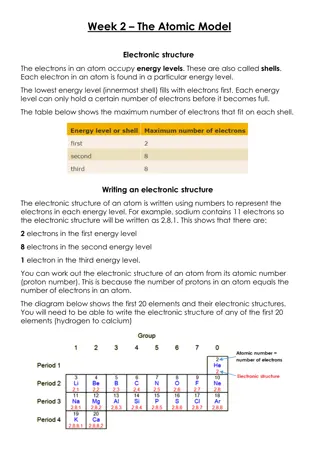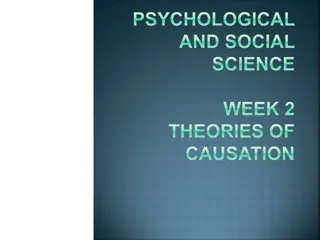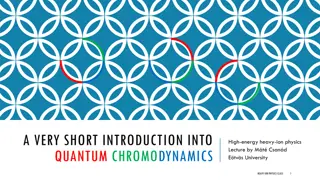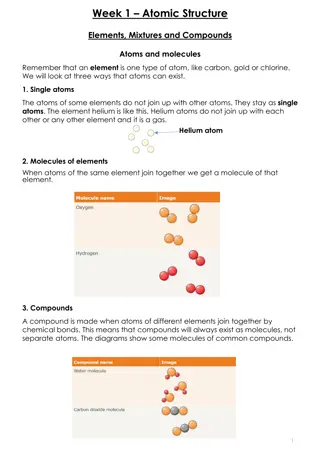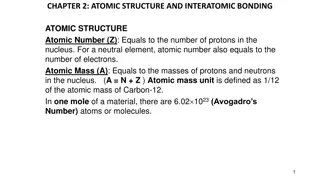
Key Figures in Atomic Physics Discoveries
Explore the contributions of Dalton, Faraday, Crookes, Thomson, G.P. Thomson, Millikan, and Rutherford to atomic physics. From Dalton's atomic theory to Thomson's discovery of the electron and Millikan's oil-drop experiment, uncover the pivotal moments in the history of atomic science.
Download Presentation

Please find below an Image/Link to download the presentation.
The content on the website is provided AS IS for your information and personal use only. It may not be sold, licensed, or shared on other websites without obtaining consent from the author. If you encounter any issues during the download, it is possible that the publisher has removed the file from their server.
You are allowed to download the files provided on this website for personal or commercial use, subject to the condition that they are used lawfully. All files are the property of their respective owners.
The content on the website is provided AS IS for your information and personal use only. It may not be sold, licensed, or shared on other websites without obtaining consent from the author.
E N D
Presentation Transcript
Arrhenius and Faraday Faraday invented an early form of what was to become the Bunsen burner introduction of spectrum analysis discovering the laws of electrolysis, and for popularizing terminology such as anode, cathode, electrode, and ion, terms proposed in large part by William Whewell Michael Faraday, 1842
Crookes cathode-ray studies, fundamental in the development of atomic physics discovery was that of the element thallium, announced in 1861 He developed the Crookes tubes investigating cathode rays. He published numerous papers on spectroscopy and conducted research on a variety of minor subjects. In his investigations of the conduction of electricity in low pressure gases, he discovered that as the pressure was lowered, the negative electrode (cathode) appeared to emit rays (the so-called "cathode rays", now known to be a stream of free electrons, and used in cathode ray display devices) Sir William Crookes in 1906
J.J. Thomson showed that cathode rays were composed of previously unknown negatively charged particles, which he calculated must have bodies much smaller than atoms and a very large value for their charge-to- mass ratio. Thus he is credited with the discovery and identification of the electron; and with the discovery of the first subatomic particle. Thomson is also credited with finding the first evidence for isotopes of a stable (non-radioactive) element in 1913, as part of his exploration into the composition of canal rays (positive ions). His experiments to determine the nature of positively charged particles, with Francis William Aston, were the first use of mass spectrometry and led to the development of the mass spectrograph. Thomson was awarded the 1906 Nobel Prize in Physics for the discovery of the electron and for his work on the conduction of electricity in gases Seven of his students, and his son George Paget Thomson, also became Nobel Prize winners.
George Paget Thomson Nobel laureate in physics recognised for his discovery with Clinton Davisson of the wave properties of the electron by electron diffraction.
Millikan series of experiments to determine the electric charge carried by a single electron.( Oil-drop experiment) In 1914 Millikan took up with similar skill the experimental verification of the equation introduced by Albert Einstein in 1905 to describe the photoelectric effect. He used this same research to obtain an accurate value of Planck s constant.
Rutherford In early work he discovered the concept of radioactive half-life, proved that radioactivity involved the transmutation of one chemical element to another, and also differentiated and named alpha and beta radiation (McGill University in Canada) It is the basis for the Nobel Prize in Chemistry he was awarded in 1908 "for his investigations into the disintegration of the elements, and the chemistry of radioactive substances", he and Thomas Royds proved that alpha radiation is helium nuclei. Rutherford performed his most famous work after he became a Nobel laureate. In 1911, although he could not prove that it was positive or negative,he theorized that atoms have their charge concentrated in a very small nucleus and thereby pioneered the Rutherford model of the atom, through his discovery and interpretation of Rutherford scattering in his gold foil experiment. He is widely credited with first "splitting the atom" in 1917 in a nuclear reaction between nitrogen and alpha particles, in which he also discovered (and named) the proton Under his leadership the neutron was discovered by James Chadwick in 1932 and in the same year the first experiment to split the nucleus in a fully controlled manner, performed by students working under his direction, John Cockcroft and Ernest Walton.
Aston his discovery, by means of his mass spectrograph, of isotopes, in a large number of non-radioactive elements, and for his enunciation of the whole number rule
Chadwick Using Geiger's recently developed Geiger counter, Chadwick was able to demonstrate that beta radiation produced a continuous spectrum, and not discrete lines as had been thought. He was Rutherford's assistant director of research at the Cavendish Laboratory for over a decade at a time when it was one of the world's foremost centres for the study of physics, attracting students like John Cockcroft, Norman Feather, and Mark Oliphant. Chadwick pursued a line of research that led to his discovery of the neutron in 1932,
Planck In 1894 Planck turned his attention to the problem of black- body radiation. Planck postulate proposed that electromagnetic energy could be emitted only in quantized form, in other words, the energy could only be a multiple of an elementary unit Among these applications and developments may be mentioned Einstein's explanation of the photoelectric effect.
Maxwell formulate the classical theory of electromagnetic radiation, bringing together for the first time electricity, magnetism, and light as manifestations of the same phenomenon.
Einstein In 1905, which has been called Einstein's annus mirabilis (miracle year), he published four ground breaking papers, on the photoelectric effect, Brownian motion, special relativity, and the equivalence of mass and energy In a 1905 paper, Einstein postulated that light itself consists of localized particles (quanta). Einstein's light quanta were nearly universally rejected by all physicists, including Max Planck and Niels Bohr. This idea only became universally accepted in 1919, with Robert Millikan's detailed experiments on the photoelectric effect, and with the measurement of Compton scattering.
Kirchhoff and Bunsen research on the fixed lines of the solar spectrum, and on the inversion of the bright lines in the spectra of artificial light. He contributed greatly to the field of spectroscopy by formalizing three laws that describe the spectral composition of light emitted by incandescent objects
Bohr In 1913 Bohr, by accident, stumbled across Balmer's numerology for the hydrogen spectrum, and in a flash came up with a workable model of the atom. The model asserts that: The planetary model is correct. When an electron is in an "allowed" orbit it does not radiate. Thus the model simply throws out classical electromagnetic theory. Technical note: an allowed orbit is one in which the electron mass times its speed times the radius of the orbit is equal to a positive integer n times Planck's constant divided by 2 pi. The integer n can be 1, 2, 3, 17, 108, etc. In fact, there are an infinite number of allowed orbits corresponding to the infinite number of positive integers. When an electron absorbs energy from incident electromagnetic radiation, it "quantum jumps" into a higher energy allowed state. This higher energy state corresponds to an allowed orbit with a higher value of the integer n. When an electron is in a higher energy state, it can quantum jump into a lower energy state, one with a smaller value of n, emitting all of its energy as a single photon of electromagnetic energy.
Michelson known for his work on the measurement of the speed of light and especially for the Michelson Morley experiment. While at Annapolis, he conducted his first experiments of the speed of light, as part of a class demonstration in 1877. His Annapolis experiment was refined, and in 1879, he measured the speed of light in air to be 299,864 51 kilometres per second, and estimated the speed of light in vacuum as 299,940 km/s,
Sommerfeld He introduced the 2nd quantum number (azimuthal quantum number) and the 4th quantum number (spin quantum number). He also introduced the fine- structure constant and pioneered X-ray wave theory.
Sommerfeld and Debye His first major scientific contribution was the application of the concept of dipole moment to the charge distribution in asymmetric molecules In 1913, he extended Niels Bohr's theory of atomic structure, introducing elliptical orbits, a concept also introduced by Arnold Sommerfeld. In 1914 1915, Debye calculated the effect of temperature on X-ray diffraction patterns of crystalline solids
In his 1924 PhD thesis he postulated the wave nature of electrons and suggested that all matter has wave properties. This concept is known as the de Broglie hypothesis, an example of wave-particle duality, and forms a central part of the theory of quantum mechanics.
Schrdinger Schr dinger heard of de Broglie s electron wave, it immediately occurred to him that this idea could be used to solve the problem of electron behaviour inside an atom. Schr dinger and others created the physics to describe electrons behaving like waves inside an atom. Schr dinger s proposed wave mechanics was firmly based on the existing quantum concepts, and for this reason is usually referred to as quantum mechanics. According to Schr dinger, the electron can only have certain (quantized) energies because of the requirement for only whole numbers of wavelengths for the electron wave. the wave equations from quantum mechanics can be manipulated to produce a three dimensional probability distribution of the electron in an orbital specified by the quantum numbers. This is known as an electron probability density and can be represented in a variety of ways.
Pauli In 1924, Pauli proposed a new quantum degree of freedom (or quantum number), with two possible values, to resolve inconsistencies between observed molecular spectra and the predictions of quantum mechanics. In particular, the spectrum of atomic hydrogen had a doublet, or pair of lines differing by a small amount, where only one line was expected. Pauli formulated his exclusion principle, stating that "There cannot exist an atom in such a quantum state that two electrons within [it] have the same set of quantum numbers."
Heisenberg Heisenberg's uncertainty principle, quantum mechanics shows that certain pairs of physical properties, like position and speed, cannot both be known to arbitrary precision: the more precisely one property is known, the less precisely the other can be known. This statement is known as the uncertainty principle. The uncertainty principle isn't a statement about the accuracy of our measuring equipment, but about the nature of the system itself the uncertainty principle is inherent in the properties of all wave-like systems Heisenberg gave, as an illustration, the measurement of the position and momentum of an electron using a photon of light. In measuring the electron's position, the higher the frequency of the photon, the more accurate is the measurement of the position of the impact, but the greater is the disturbance of the electron, which absorbs a random amount of energy, rendering the measurement obtained of its momentum increasingly uncertain (momentum is velocity multiplied by mass), for one is necessarily measuring its post-impact disturbed momentum from the collision products and not its original momentum. With a photon of lower frequency, the disturbance (and hence uncertainty) in the momentum is less, but so is the accuracy of the measurement of the position of the impact

